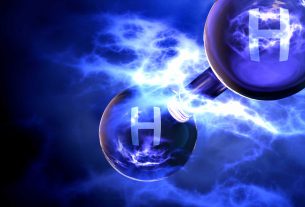Germany – The valuable energy source hydrogen is being created by a group of researchers at the Fraunhofer Institute for Manufacturing Engineering and Automation IPA using waste materials.
The success of this development depends on the capture of CO2: CO2 is separated during the production of hydrogen from waste and used as a raw material in the chemical industry. By using a variety of techniques, the research team can generate carbon-negative hydrogen from organic waste in this manner, thereby removing CO2 from the atmosphere.
In Germany, there is no shortage of organic waste. About 4.6 million tons of it, according to the German Environment Agency, were disposed of in household compost bins in Germany just last year. Without accounting for waste from public parks and gardens, agriculture, food production, sewage sludge, and canteen leftovers, the total is close to 15 million tons. The majority of it is either transported to composting facilities or burned to produce heat and electricity. Carbon dioxide (CO2) emissions are produced as a result, harming our climate. Many people believe that hydrogen will be the future’s clean energy source. Only water is released during its use in energy conversion processes. But as it stands, natural gas continues to be a major source of hydrogen production. Much more environmentally friendly would be a production method based on plant waste, similar to electrolysis using renewable electricity.
Lowering CO2 concentration
In the recent years, a wide range of processes for converting biomass into hydrogen have been developed. The team assessed which of these processes are technologically developed and have the potential to be run effectively in the future as part of their analysis. The new conversion techniques are also anticipated to address one shortcoming of conventional organic waste management practices: Whether biomass is burned or composted, it always emits carbon dioxide that the plants had previously absorbed from the atmosphere through photosynthesis. It would be more sensible to extract this greenhouse gas from the plants with the goal of storing it underground in defunct natural gas fields or using it as a raw material in the chemical industry.
Potential of biomass
The potential of biomass is illustrated by a project Fraunhofer IPA is running with a company in the metal industry. In this project, cardboard, wood, and canteen waste can all be converted into hydrogen along with waste from nearby fruit growers and winemakers. The processing of metals then makes use of this hydrogen directly. The leftover fruit and canteen waste are fermented in the first step of the procedure using bacteria and dark containers to create hydrogen and carbon dioxide. A conventional biogas plant can then use a second fermentation process to transform the fermented mass into methane. The methane is then transformed into CO2 and hydrogen. Contrarily, it is challenging to ferment wood and paper fibers in this manner. A wood gasifier can split them into CO2 and hydrogen. In order to select the most appropriate and effective technologies, Fraunhofer IPA is comparing the various process options as part of this project. Additionally, IPA researchers are creating technical optimization methods to cut costs and guarantee that the corresponding processes are as eco-friendly as possible.
Hydrogen from purple bacteria
Purple bacteria are especially good at making hydrogen from dairy and fruit waste. The bacterium has been modified by scientists at the University of Stuttgart so that it hardly needs light, which reduces the energy needed for the process of producing hydrogen. They are looking into ways to produce hydrogen with purple bacteria on a larger scale in the future in collaboration with Fraunhofer IPA. The Fraunhofer IPA team is working together with the Fraunhofer Institute for Interfacial Engineering and Biotechnology IGB as part of the H2Wood – BlackForest project to investigate how microbes can decompose wood waste into hydrogen and other beneficial molecules for the chemical industry. Campus Schwarzwald and the Institute of Industrial Manufacturing and Management IFF at the University of Stuttgart are additional project collaborators.
Hydrogen hubs
The Fraunhofer IPA study “Industrial Hydrogen Hubs in Baden-Württemberg” (abbreviated “I-H2-Hub-BW”) shows that green hydrogen has the potential to meet some energy needs of specific industrial sectors and heavy goods traffic locally. The researchers discovered that hub-based decentralized hydrogen production and use can be profitable if the distribution centers are positioned strategically. These hubs run electrolyzers that separate water into hydrogen and oxygen using green electricity. The hubs need to be as close to the consumers as possible to minimize transportation costs. The local industry’s requirement for process heat, high-temperature processes, and hydrogen gas, for instance for the production of nitrogen fertilizer, is the second crucial factor in the choice of location.
The research team, led by Henke, identified potential locations in Baden-Württemberg using the location criteria, particularly the Rhine-Neckar metropolitan region and the greater Karlsruhe area. Fraunhofer IPA researchers used computer simulations to show that, under certain conditions, green hydrogen produced locally could replace 30 percent of fossil energy within ten years using only the state’s own open spaces.




